
KIDV Recyclecheck 2022
Sustainable packaging is the future. Here, recyclability plays a giant role. But to achieve recyclable packaging, there are many uncertainties. To help with this, the KIDV developed a series of Recyclechecks.
This Recyclecheck consists of a decision tree. Here, you answer a series of questions about your packaging or product. Based on the answers, the degree of recyclability is determined.
KIDV is aware of and tries its best to keep up with the many developments and changes occurring in the market. If
necessary, the Recyclecheck will be updated in close conference with the relevant chain parties. (Recyclass, Petcore Europe, EPBP)
Read the full KIDV Recyclecheck here.
WHAT IS GOOD RECYCLABLE PACKAGING?
According to KIDV, good recyclable packaging must meet 4 conditions:
- The packaging is collected or picked up by authorized waste collectors
- It gets sorted into predefined streams for the recycling process
- The material is industrially processed and the raw material is recovered
- The recovered raw material gets reused in the production of other products or packaging
If you meet these 4 conditions, your packaging is recyclable. In the decision tree your packaging can end up in 1 of the 4 following categories:
- Not recyclable: this packaging contains substances that interfere with recycling
- Limited recyclability: during the sorting process it ends up in the mixed stream. That means that the remaining granulate can't get used broadly. Sometimes these packages are also not sorted into the correct stream
- Reasonable recyclability: these packages affect the quality of the recyclate or the recycling process.
- Good recyclability: the packaging follows the definition of the KIDV is are therefore well recyclable.
The KIDV closely follows the many changes and developments in the market. The recycle check focuses on the Dutch market. Because they have drawn up the Recycle Check with various organizations in Europe (such as Recyclass, Petcore Europe en de EPBP), this information is relevant for all of us. And it offers insight into how they make choices and why they do so.
THE DIFFERENT COMPONENTS OF PACKAGING
Packaging gets disposed of in multiple parts and at different times. The Recycle Check can serve for the entire packaging or the different parts. These parts are called disposable units..
In the case of 1 disposable unit, we are talking about e.g. a bottle with a cap and a label. Here it is logical that everything is thrown away at once. For products with 2 or more disposable units, the parts are discarded separately. E.g. A dessert tray with a cardboard wrapper. The tray ends up with plastic waste and the cardboard wrapper with paper.
Determining whether it is 1 or more discard units is sometimes difficult. Therefore, there are also conditions that packaging with multiple discard units must meet to be properly recyclable:
- The packaging components are easily separable by the consumer
- The packaging contains instructions on how to dispose of and separate the packaging. For more information: consult the Disposal Guide
- The consumer will likely separate the packaging and dispose of it separately. These conditions can be demonstrated by examining consumer behavior
A discard unit is divided again into a main component and subcomponents. The material that makes up the main component is taken into account for the Recycle Check. The main component is the largest part of the packaging. E.g. with a bottle, you have the bottle, the cap, and the label. The bottle is the main component. The cap and label are the subcomponents.
THE DECISION TREE
Now that we understand what constitutes recyclable packaging and how it is composed, we are sufficiently informed to assess the recyclability of molded plastic packaging. The decision tree got created for this purpose.
The decision tree is divided into 3 different trees:
- Decision tree Recyclecheck for Rigid Plastic Packaging
- Continuation decision tree Rigid Packaging - PET
- Continuation decision tree Rigid Packaging - PP and PE
First, we determine the possibility of collection. Then we assess the recyclability of the packaging. We ask ourselves the questions:
- Is it rigid plastic packaging? If so, can you continue
- Did the packaging serve medical or chemical products? If not, you can continue
- Did the bottle serve soft drinks or water, and is it covered by the deposit requirement? If not, you may continue.
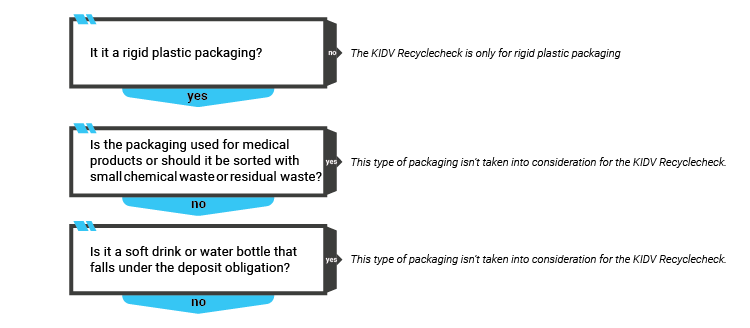
If you answered the questions correctly, the packaging can be collected.
Now we look at the recyclability of the packaging:
- Is the packaging free of oxo-degradable material? If yes, continue
- Is the packaging free of PVC, PVdC, or PETG in the packaging? If yes, continue
- Is the packaging free of elastomers or silicones? If yes, please continue.
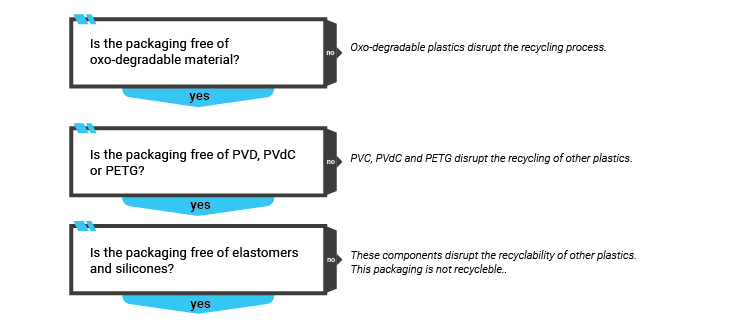
If we answer everything as it should be, we have a packaging that we can collect without any disturbances. Now we need to assess whether we can sort the packaging:
- Is the packaging larger than 5cm, and is the volume smaller than 5l? If yes, go to the next step
- Is the main component of the package a color other than black? If yes, answer the following question
- Is the main component made of PE, PP, or PET? Each of these materials has a separate decision tree.
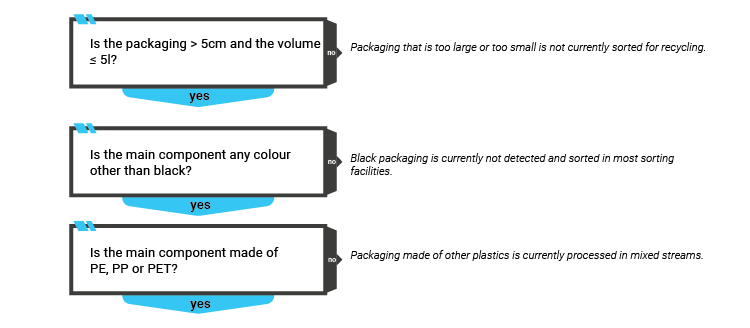
Our packaging can now be collected, contains no disruptive substances, and can get sorted. But per material type, the rules are different.
MATERIAL TYPES DURING RECYCLING
PET
We first look at the decision tree for packaging with PET as the main component. This decision tree consists of 6 questions. In general, PET packaging goes from limited recyclable to good recyclable. But a lot depends on the composition of the discard unit.
For this, we look at the size, labels, or sleeves and assess this with their decision tree.
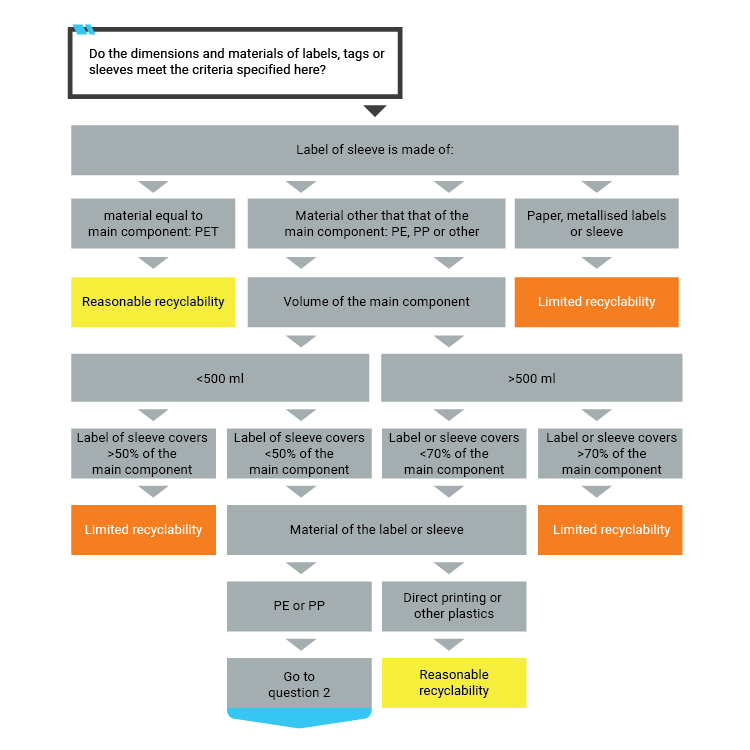
For the 2nd question, we pay attention to the subcomponents such as films, metal parts, lid, etc.
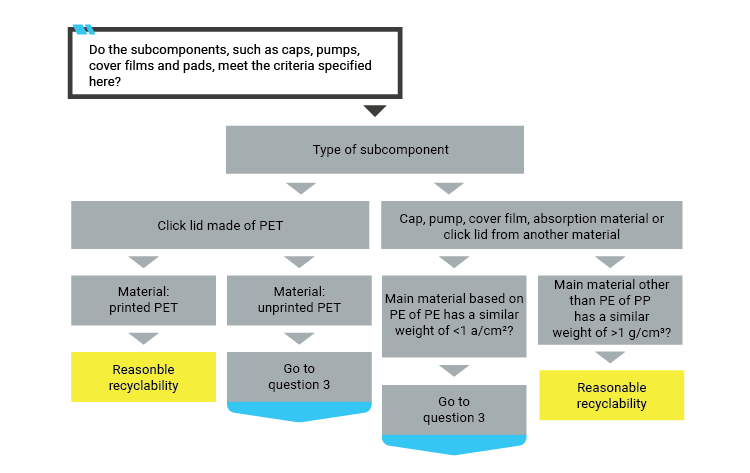
The remaining questions are easier to observe:
- Does the adhesive for the labels or sub-components dissolve in warm water?
- Is the main component colorless PET?
- Is the mono-material PET?
- Is the PET container a bottle?
If we answer "yes" to all these questions we have packaging with good recyclability. In the image below all of the questions are listed again.
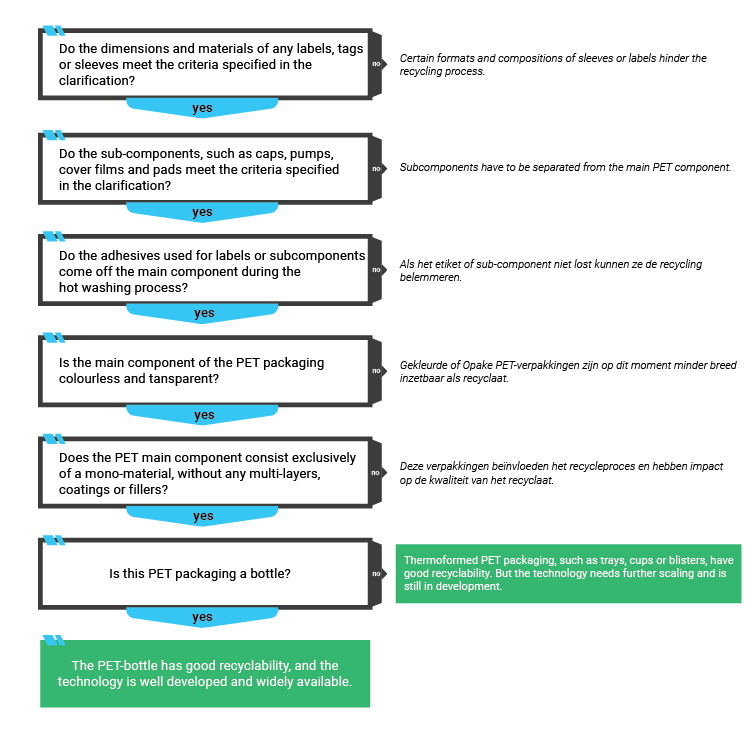
What catches our eye, is that if the PET packaging is not a bottle but a thermoformed packaging, such as a tray, cup, or blister, they have good recyclability. Currently, the technology is still developing and needs to be scaled up further.
PP and PE
For PP and PE, the assessment is slightly less complex. The first 2 questions still have a separate decision tree but there are only 4 questions to answer.
To answer the first question, we again look at the size and material of the sleeves or labels.
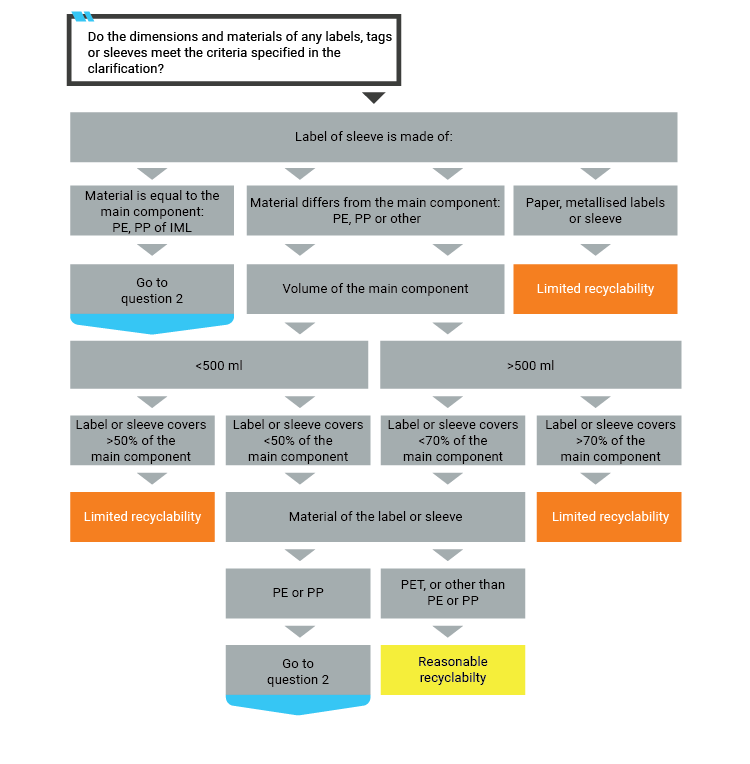
Now we look at the different subcomponents and whether they meet the requirements.
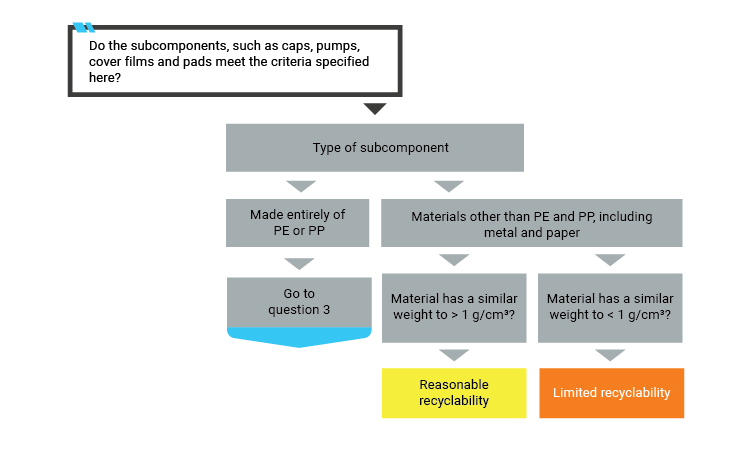
For the last questions, we assess the solubility of the adhesives and whether the material consists of mono-material PP or PE.
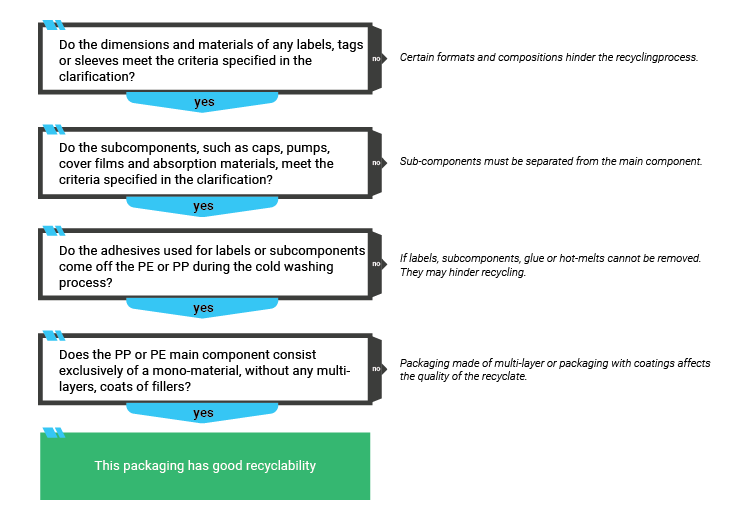
Conclusion
We can recycle more materials easily due to technological progress. But there are still some barriers. Therefore, we should try to keep the recycling streams as pure as possible and make as much packaging as possible from mono-material.
Black packaging continues to cause difficulties in the recycling process. They don't get sorted correctly. Currently, there are developments underway that would not cause interference, but there is not enough research to use them yet. Plain-colored packaging has less of this problem and is therefore reasonably recyclable.
Due to developments in technology or packaging materials, we can say that plastic has its place in the circular economy.
